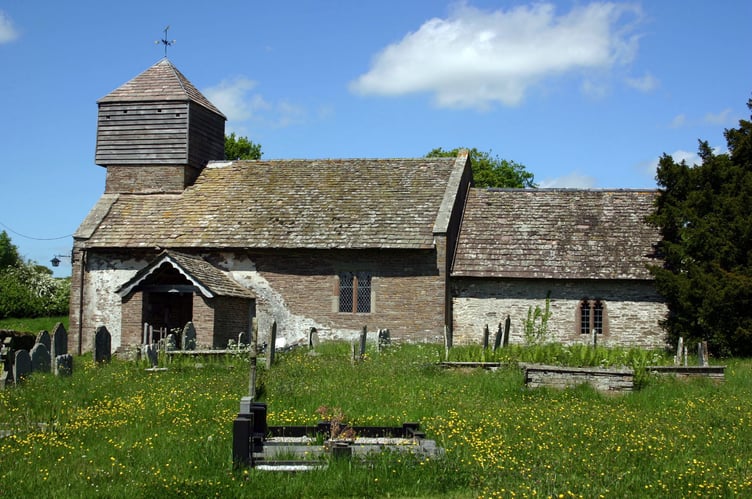Situated just over the border in Herefordshire, to the east of the Black Mountains it is a fascinating area to explore with many historic buildings, intriguing legends and beautiful unspoilt countryside, yet surprisingly it is largely ignored by tourists.
Newton St Margarets - from Turnastone I drove up towards the western ridge of the Golden Valley and then took the first turning on the left, signposted to St Margaret’s Church.
This narrow road, high above the the Golden Valley took me past Upper Maes-coed and Gilfach and descended to St Margaret’s Church which is situated nearly 800 feet above sea level.
There are magnificent views over the Herefordshire plain and towards Dinedor, Aconbury, Garway Hill and westward to the Black Mountains.
From the outside this simple church looks very plain and its location seems very remote, but it is probably due to its isolation that a remarkable treasure within its walls has escaped the actions of Tudor Reformation, the Cromwellian destruction and the misplaced zeal of Victorian restoration, yet at the same time it is rarely mentioned in modern guidebooks.
I had travelled here to see an exquisite rood-loft that the architectural writer Niklaus Pevsner described as ‘one of the wonders of Herefordshire’.
When H.J. Massingham came here in 1950, he was moved to comment: ‘The extraordinary finesse of the carving, its delight in nature and its avoidance of a ponderous naturalism, together with the elegance of the structure as a whole, reveal the highest craftmanship and a sense of composition which transcends it.’
It was a fine compliment indeed, to the 16th century craftsmen and Massingham went on to add: “It seems that any art that can turn oak planks into a paridisal garden rightly claims our wonder and honour as a creative masterpiece both of opulence and delicacy.’
I could not help thinking that the workmanship of the carving is less ornate than the well known screen at Partrishow in the Black Mountains, but it is perhaps more delicate in design. Dating from about 1580, it was executed by Tudor craftsmen and is constructed of silver grey oak and extends across the full width of the church.
There is actually no ‘screen’ as such, but just two elaborately carved and gilded posts supporting the rood loft. The small niches in each post would have originally held figures of the Virgin Mary and St John.
After the Reformation, an order was made in 1547 to destroy all images, and nearly every rood in the country vanished with its images.
Fortunately, the destruction of the lofts was left to the discretion of each parish and this one survived.
The crossbeam resting on these posts has a band of foliage with a line of hundreds of tiny fleur-de-lys above it.
In each of the two pillars supporting the rood-loft is a niche for an effigy while the pillars themselves are elaborately carved in sets of four panels with minute crocketed pinnacles along the ribbing of the shafts.
Beneath the loft, the carving has numerous bosses at the intersections and they are carved with such curiosities as a man’s face with his tongue poking out, various interlaced knots, foliage, a cross on a shield and other devices.
At one time the rood-loft would have been richly painted and gilded, as was noted by Duncombe, who wrote a history of Herefordshire in 1805 and commented: ‘The effect of the whole is increased by gilding and painting in various colours. There are only about six rood lofts left in England and this one is said to be the best example.’
There is a doorway in one corner of the chancel giving access to a short flight of stone steps set inside the thickness of the wall.
They rise up to the gallery which would have been used in former times by musicians and singers during services.
A window in the east wall of the chancel has two lights of stained glass depicting a modern representation of St Margaret as a shepherdess, carrying a replica of the church on her right arm.
When the Herefordshire Woolhope Society came here in 1885 they reported that there were skeletons painted on a wall of the church (probably similar to the one at Partrishow), but these are no longer to be seen.
There are a number of restored wall paintings of Biblical texts and one of them is positioned directly above the south door, so that you can read it as you leave the church.
It commands you to ‘Go and Sin no more’ !
Outside the church, I noticed a square slab of stone which has been let into the north wall near the west end.
This was used in connection with the once popular game of fives, a form of handball which used to be played when churchyards served as centres of community activities in these remote villages.
Perched above the west end of the nave is a weather boarded turret containing three bells and apparently the smallest one is inscribed, ‘Peace and good neighbourhood, W.E. 1745 ’.
The initials relate to the bell founder, William Evans of Chepstow.
The other two bells bear the inscription, ‘Recast by John Warner and Son, London, 1901’.
I then examined the grave stones and the most interesting one that I noted is situated just beyond the yew tree.
It commemorates Harriet, who died at the age of 77 in 1910.
She was the wife of William Powell of Rock Cottage. the inscription also tells us that ‘She was the District Nurse. Attended 526 births and never lost a Mother’.
Until 1852, this little church was in the diocese of St David’s, but it was then transferred to the See of Hereford.
Before the Reformation, the living would have belonged to Llanthony Priory.

Comments
This article has no comments yet. Be the first to leave a comment.